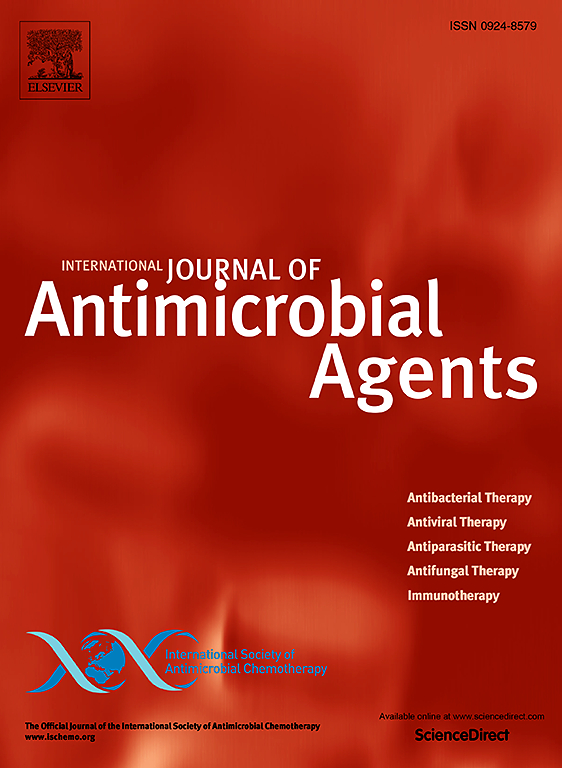Clinical application of customized and non-customized bacteriophage therapy in patients with refractory/resistant bacterial infections: A systematic review and meta-analysis
IF 4.6
2区 医学
Q1 INFECTIOUS DISEASES
International Journal of Antimicrobial Agents
Pub Date : 2025-07-07
DOI:10.1016/j.ijantimicag.2025.107570
引用次数: 0
Abstract
Background
Patients with refractory/resistant bacterial infections face high mortality rates. Bacteriophage therapy (PT) is a viable solution, but clinical evidence remains fragmented. This review synthesizes current evidence on PT efficacy, safety, and implementation, with additional analysis by customization strategies: non-customized, customized selection and customized production.
Method
We examined clinical studies on PTs for refractory/resistant bacterial infections and pooled efficacy and safety outcomes by customization strategy from randomized controlled trials, observational studies, cohorts, case series and case reports using a random-effects model. Subset sensitivity analyses were conducted, and individual patient data were further analysed. Risk of bias was assessed for each study.
Result
As of 14 May 2025, 16 226 articles were identified, and 130 studies (1115 patients) were included: 559 non-customized, 451 customized selection and 105 customized production. Risks of bias were low to serious. Clinical improvement (I2 87%) and bacterial eradication (I2 94%) rates were 71% (95% confidence interval [CI], 60–80) and 51% (95% CI 30–72), respectively. Customized production group had the highest success rates (79% and 87%), albeit at a cost. Time taken for customization often resulted in delays in PT. Higher titres and multiple administration routes were associated with better bacterial eradication. Efficacy improvement compared to control was statistically insignificant. Adverse events were mild to moderate. Phage neutralization appeared before, during, and after PT cessation. Impacts on pharmacokinetics remain uncertain. Immunological markers varied across studies.
Conclusions
PT shows promising clinical outcomes, but significant gaps in clinical evidence persist, warranting well-designed trials. Laboratory-based phage monitoring shows promise but requires systematic investigation.
定制和非定制噬菌体治疗在难治性/耐药性细菌感染患者中的临床应用:一项系统综述和meta分析。
背景:难治性/耐药性细菌感染患者面临高死亡率。噬菌体治疗(PT)是一种可行的解决方案,但临床证据仍然不完整。本综述综合了目前关于PT疗效、安全性和实施的证据,并对定制策略进行了额外的分析:非定制、定制选择和定制生产。方法:我们通过随机对照试验、观察性研究、队列、病例系列和使用随机效应模型的病例报告的定制策略,检查了PTs治疗难治性/耐药性细菌感染的临床研究,并汇总了疗效和安全性结果。进行亚组敏感性分析,并进一步分析个体患者资料。对每项研究的偏倚风险进行评估。结果:截至2025年5月14日,共纳入16226篇文献,130项研究(1115例患者):非定制化559篇,定制化选择451篇,定制化生产105篇。偏倚风险从低到严重。临床改善(I2 88%)和细菌根除(I2 94%)率分别为72%(95%可信区间[CI], 61 ~ 81)和51% (95%CI, 30 ~ 72)。尽管有成本,定制生产组的成功率最高(79%和87%)。定制所需的时间通常导致PT的延迟。更高的滴度和多种给药途径与更好的细菌根除相关。与对照组相比,疗效改善无统计学意义。不良事件为轻至中度。在停药前、停药期间和停药后均出现噬菌体中和。对药代动力学的影响仍不确定。免疫标记物在不同的研究中有所不同。结论:PT具有良好的临床效果,但临床证据存在显著差距,需要精心设计的试验。基于实验室的噬菌体监测显示出前景,但需要系统的调查。
本文章由计算机程序翻译,如有差异,请以英文原文为准。
求助全文
约1分钟内获得全文
求助全文
来源期刊
CiteScore
21.60
自引率
0.90%
发文量
176
审稿时长
36 days
期刊介绍:
The International Journal of Antimicrobial Agents is a peer-reviewed publication offering comprehensive and current reference information on the physical, pharmacological, in vitro, and clinical properties of individual antimicrobial agents, covering antiviral, antiparasitic, antibacterial, and antifungal agents. The journal not only communicates new trends and developments through authoritative review articles but also addresses the critical issue of antimicrobial resistance, both in hospital and community settings. Published content includes solicited reviews by leading experts and high-quality original research papers in the specified fields.

 求助内容:
求助内容: 应助结果提醒方式:
应助结果提醒方式:


